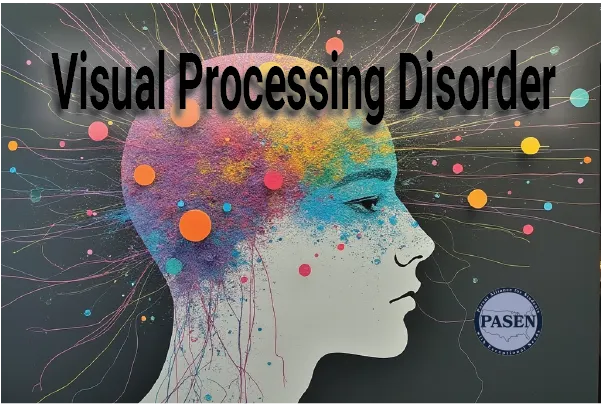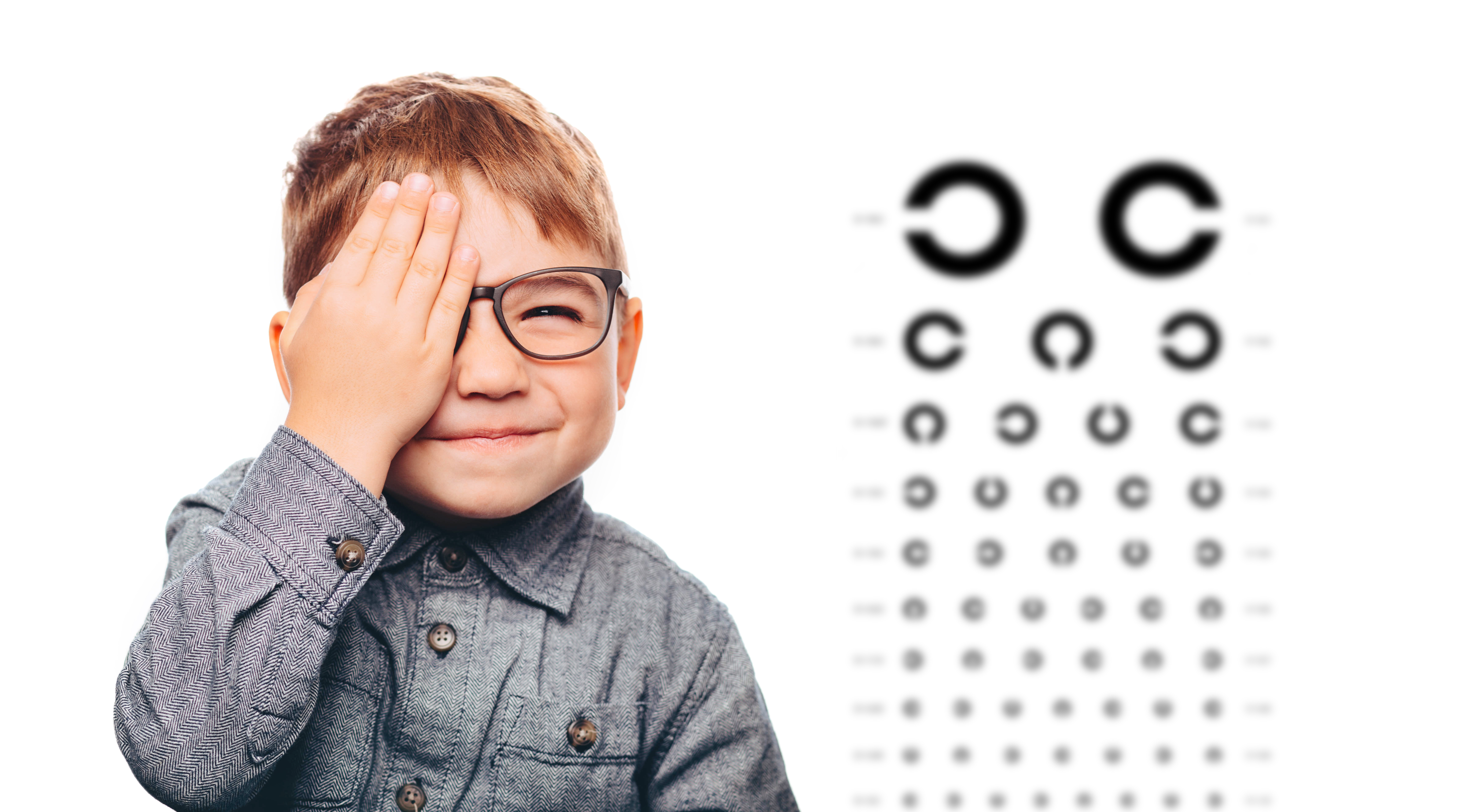
Understanding Visual Processing Disorders
Understanding Visual Processing Disorder
How It Differs from Dyslexia
Visual Processing Disorder (VPD) and Dyslexia are two distinct conditions that can significantly impact a child’s ability to learn, particularly in reading and other academic tasks. While both conditions affect how a person processes information, they do so in different ways. Understanding these differences is crucial for parents, educators, and anyone involved in a child’s education.
Visual Processing Disorder is a condition where the brain struggles to process and make sense of visual information received from the eyes. It's important to note that VPD is not related to how well a person sees (visual acuity). A child with VPD can have perfect 20/20 vision yet still experience difficulties with how their brain interprets what they see. This can manifest in challenges such as distinguishing between similar-looking letters and numbers, poor hand-eye coordination, and issues with visual memory, among other symptoms.
On the other hand, Dyslexia is a specific learning disability that primarily affects reading. Children with dyslexia often have trouble recognizing and recalling written words, which can make it difficult for them to develop automaticity in reading. This means they might need to repeatedly revisit and relearn words that typical readers would recognize instantly. Dyslexia is fundamentally about how the brain processes written language, making it challenging for individuals to read fluently, even when they understand the content.
While these two conditions are different, they can sometimes overlap, making it challenging to distinguish between them. For instance, a child with dyslexia might also exhibit difficulties that seem related to visual processing, further complicating their learning experience. This overlap underscores the importance of thorough evaluations to correctly identify the root causes of a child’s reading difficulties.
Differentiating VPD from Other Visual Issues
It's important to understand that Visual Processing Disorder is not the same as having vision problems like nearsightedness or farsightedness. Those are issues with visual acuity, where the eyes themselves do not see clearly. In contrast, VPD is about how the brain interprets what the eyes see, not about the clarity of the vision itself.
For example, a child with nearsightedness may struggle to see the board at the front of the classroom, but once their vision is corrected with glasses, they can see and learn just fine. However, a child with VPD might see the board clearly but still struggle to understand or remember the information because their brain isn’t processing it correctly.
Recognizing these distinctions is the first step in ensuring that children receive the right type of support and intervention. Misdiagnosis or overlooking these conditions can lead to ineffective treatment plans, further frustrating the child and impeding their academic progress.
In the following sections, we’ll delve deeper into the symptoms of Visual Processing Disorder, how it can be diagnosed, and the best ways to support children who are affected by it.

Top 7 Signs of Visual Processing Disorder
Identifying the signs of a Visual Processing Disorder (VPD) early on can be crucial in providing the right support for your child. VPD can impact a child's learning and daily activities, making tasks that require visual processing more challenging. Below are the top 7 signs of VPD that you might notice in a child struggling with visual processing:
Difficulty Recognizing Letters and Numbers
Children with VPD often struggle to distinguish between similar-looking letters and numbers, such as "b" and "d" or "6" and "9." This can lead to significant challenges in reading and math, where precise recognition is key.Problems with Hand-Eye Coordination
Tasks that require coordination, such as handwriting, catching a ball, or using tools like scissors, can be particularly difficult. This lack of coordination often results in frustration and can affect a child's confidence in school and play activities.Issues with Spatial Awareness
Children with VPD may have trouble judging distances, positions, or spatial relationships between objects. This can impact their ability to navigate spaces, complete puzzles, or even line up numbers and words correctly on a page.Trouble with Visual Sequencing
Visual sequencing involves remembering the order of letters, numbers, or images. A child with VPD might mix up the order of letters in a word or struggle with following multi-step visual instructions, leading to difficulties in reading, spelling, and math.Visual Memory Problems
Remembering visual information can be a challenge, affecting both short-term and long-term memory. A child may forget what they've just read or struggle to recognize familiar objects, impacting their ability to learn and retain information.Difficulty Copying from the Board
In a classroom setting, copying text or diagrams from the board can be a daunting task. Children with VPD may lose their place frequently or miscopy details, making it hard for them to keep up with their peers.Problems with Visual Discrimination
Distinguishing between similar shapes, patterns, or objects can be tough. This can lead to mistakes in reading and writing, where even slight differences in letters or numbers are crucial.
Want to learn more? These are a few of the most common signs, but many other symptoms could indicate a Visual Processing Disorder. For a comprehensive list of 20 possible symptoms, including less common but equally important indicators, simply sign up for our newsletter by entering your email below, and we'll send you the full list.

Understanding Visual Processing Skills
Visual Processing Disorder (VPD) can affect a wide range of visual processing skills, each of which plays a crucial role in interpreting and responding to the visual world. Here are the key visual processing skills that may be impacted by VPD:
Visual Discrimination
Visual discrimination is the ability to identify similarities and differences in visual images. This skill allows children to distinguish between different shapes, sizes, colors, objects, and patterns. For example, a child with good visual discrimination can distinguish between a "b" and a "d" or identify subtle differences between two similar objects. Challenges in this area can lead to difficulties in reading and math, where recognizing differences is essential.
Visual Memory
Visual memory involves remembering visual information over both short-term and long-term periods. This skill is critical for tasks like reading, where a child must remember what a word looks like after seeing it. A child with poor visual memory might struggle to recognize words they've seen before or have trouble recalling the appearance of objects, which can impact their ability to learn and retain information.
Spatial Relations
Spatial relations refer to understanding the position of objects in space relative to oneself and to other objects. This skill is essential for tasks that require navigation, such as reading maps, solving puzzles, or understanding geometric concepts in math. Children with difficulties in spatial relations may have trouble judging distances, organizing their workspace, or even correctly lining up numbers and letters on a page.
Form Constancy
Form constancy is the ability to recognize objects, shapes, symbols, and letters despite changes in size, position, or environment. For instance, a child with strong form constancy skills can recognize a letter or shape, whether it is written in a different font, size, or orientation. If a child struggles with form constancy, they might find it challenging to recognize familiar objects or letters when they appear differently, affecting their reading and writing abilities.
Sequential Memory
Sequential memory is the ability to remember a series of forms, numbers, letters, or objects in order. This skill is vital for following instructions, solving problems in math, or reading sequences of letters to form words. A child with poor sequential memory may need help remembering the order of steps in a process or the sequence of letters in a word, leading to confusion and errors.
Figure-Ground Discrimination
Figure-ground discrimination is the ability to distinguish a figure from its background. This skill helps children focus on important information while ignoring irrelevant details. For example, a child with good figure-ground discrimination can easily spot a word on a crowded page or pick out an object in a busy room. Difficulties in this area can make it hard for children to find information on a cluttered page, copy from the board, or locate items in a messy environment.
Visual Closure
Visual closure is the ability to recognize an object, letter, or number even when part of it is missing. This skill is important for reading, where letters or words may be partially obscured or written in a way that isn’t completely clear. A child with strong visual closure skills can "fill in the gaps" and identify what the object or word is supposed to be. If a child struggles with visual closure, they may have difficulty reading incomplete text or recognizing partially hidden objects.
Visualization
Visualization involves forming mental images of visual information. This skill allows children to create and manipulate images in their minds, which is essential for problem-solving, planning, and understanding abstract concepts. A child with difficulties in visualization might struggle to picture the events of a story while reading or to imagine how parts of a whole fit together in a puzzle or project.
These visual processing skills are fundamental to a child's ability to learn and interact with the world around them. When one or more of these skills is impaired due to Visual Processing Disorder, it can lead to a range of challenges in both academic and daily activities. Recognizing and understanding these skills is the first step in providing the necessary support and interventions to help children succeed.

Impact on Learning
Visual Processing Disorder (VPD) can have a profound impact on a child's learning, particularly in areas that rely heavily on visual-spatial skills, such as reading, math, and overall academic performance. Understanding the role of these skills and how VPD can affect them is crucial for identifying the right interventions and support strategies.
The Role of Visual-Spatial Skills in Learning
Visual-spatial skills are essential for interpreting and understanding the physical world, as well as for organizing and processing visual information. In reading, these skills help children recognize letters, words, and sentences and understand their spatial arrangement on a page. For example, a child with strong visual-spatial skills can quickly recognize the word "cat" and understand that it is different from "act," even though they contain the same letters.
In math, visual-spatial skills are critical for understanding concepts like geometry, measurement, and the spatial arrangement of numbers. Tasks such as aligning numbers in columns for addition or subtraction, understanding the relationship between shapes, or interpreting graphs and charts all require robust visual-spatial processing.
When a child has VPD, these skills are compromised, leading to difficulties in reading, math, and other academic areas. For instance, a child might struggle to line up numbers correctly, misinterpret geometric shapes, or have trouble visualizing the steps needed to solve a math problem. These challenges can result in lower academic performance, frustration, and a lack of confidence in their abilities.
How Poor Visual Processing Can Mimic
or Exacerbate Other Learning Disabilities
Poor visual processing can often mimic the symptoms of other learning disabilities, such as dyslexia. For example, both VPD and dyslexia can cause difficulties in reading, but the root causes are different. In dyslexia, the primary issue lies in processing language and phonological information, while in VPD, the difficulty is in processing and interpreting visual information.
However, these conditions can also exacerbate each other when they co-occur. A child with both dyslexia and VPD may face compounded challenges, such as struggling with both recognizing words and processing their visual arrangement on a page. This overlap can make it harder to diagnose the exact nature of the child's learning difficulties and may require a more comprehensive evaluation to ensure that both conditions are properly addressed.

Case Studies and Examples of Co-Occurring VPD and Learning Disabilities
To illustrate the impact of co-occurring VPD and learning disabilities, consider the findings from the De Bonte et al. study. In this study, researchers examined children with both VPD and another learning disability, such as dyslexia or ADHD. They found that these children often faced more significant academic challenges than those with just one condition. For example, a student with VPD and dyslexia might struggle not only with decoding words but also with visual sequencing, making it difficult to follow the flow of text and comprehend what they are reading.
In another case, a student with VPD and ADHD might have trouble staying focused on visual tasks, such as copying from the board or completing a worksheet, while also struggling with hand-eye coordination and spatial awareness. This combination of difficulties can make it hard for the student to keep up with their peers, leading to frustration and a sense of failure.
These examples highlight the importance of recognizing and addressing all aspects of a child's learning challenges. By understanding the unique impact of VPD and its interaction with other learning disabilities, educators and parents can develop more targeted and effective interventions, helping the child to overcome their challenges and achieve academic success.
In summary, Visual Processing Disorder can significantly affect a child's learning, particularly in areas that rely on visual-spatial skills. When combined with other learning disabilities, the challenges can be even more pronounced, making it essential to identify and address all contributing factors to ensure the best possible outcomes for the child.
Diagnosis and Assessment
Identifying Visual Processing Disorder (VPD) accurately is a critical step in ensuring that children receive the appropriate support and interventions. Because VPD can share symptoms with other learning challenges, such as dyslexia, comprehensive evaluations are essential to differentiate between these conditions and address each one effectively.
The Importance of Comprehensive Evaluations
When a child is struggling with learning, it’s vital to conduct a thorough and comprehensive evaluation that considers all potential contributing factors, including VPD. Too often, children are diagnosed with dyslexia or another learning disability without fully exploring the possibility that a visual processing issue might be at the root of their difficulties. A differential diagnosis that includes an assessment for VPD ensures that the full spectrum of the child's needs is understood and addressed.
For example, if a child is found to have difficulties with reading, it might initially be attributed to dyslexia. However, if the child also struggles with visual tasks such as copying from the board or distinguishing between similar letters and numbers, it’s important to assess for VPD as well. Without this comprehensive approach, the child might receive interventions that address only part of the problem, leaving other issues unaddressed and allowing learning challenges to persist.
Tools and Methods Used to Diagnose VPD
Diagnosing VPD involves a variety of specialized tools and methods that assess different aspects of visual processing. Some of the key tests used by professionals include:
NSUCO Oculomotor Test: This test assesses the child's eye movements, specifically their ability to track moving objects smoothly and accurately. Poor oculomotor control can lead to difficulties in reading, as the child may struggle to follow lines of text or keep their place on a page.
Test of Visual Perceptual Skills (TVPS): The TVPS is a comprehensive assessment tool that evaluates a range of visual processing abilities, including visual discrimination, visual memory, spatial relations, and figure-ground discrimination. By identifying specific areas of weakness, this test helps pinpoint where the child is struggling and what interventions might be necessary.
Developmental Eye Movement (DEM) Test: This test evaluates both the eye movement control and visual processing speed, which are crucial for efficient reading. It helps to identify issues that might cause a child to read slowly or lose their place frequently.
Beery-Buktenica Developmental Test of Visual-Motor Integration (VMI): The VMI assesses how well a child can integrate their visual perception with motor coordination, which is important for tasks like writing and drawing. Difficulties in this area can lead to problems with handwriting and other fine motor tasks.
These tools, along with others, provide a detailed picture of a child’s visual processing abilities and can help differentiate VPD from other learning disabilities.
The Need for Specialized Professionals
Because VPD is a complex condition that requires specialized knowledge to diagnose and treat, it’s important that children are evaluated by professionals who are trained in visual processing disorders. This typically includes developmental optometrists, neuropsychologists, and occupational therapists with expertise in visual processing.
A developmental optometrist, for example, is trained to assess how well the eyes and brain work together. They can identify issues with visual perception that might not be detected during a standard eye exam, such as difficulties with visual discrimination or spatial relations.
Neuropsychologists can conduct comprehensive assessments that consider a child’s cognitive, motor, and sensory processing abilities, providing a holistic view of their strengths and challenges. This is particularly important when a child has multiple co-occurring conditions, such as dyslexia and VPD.
Occupational therapists may also play a key role in diagnosing and treating VPD, particularly when it impacts fine motor skills and daily activities. They can offer targeted interventions that help improve visual-motor integration and other affected skills.
Given the specialized nature of VPD, it’s crucial that evaluations are conducted by professionals who have the expertise to accurately diagnose and recommend appropriate interventions. Working with a team of specialists ensures that all aspects of a child's learning challenges are addressed, paving the way for more effective support and better educational outcomes.
In summary, comprehensive evaluations that include assessments for VPD are essential for accurately diagnosing and addressing learning challenges in children. By using specialized tools and working with professionals who have expertise in visual processing disorders, parents and educators can ensure that children receive the support they need to succeed.

Breaking Down the Components of a Comprehensive Functional Vision Assessment
A Functional Vision Assessment (FVA) is a detailed evaluation that goes beyond standard eye exams to assess how well a child’s visual system works as a whole. This assessment not only examines how clearly a child sees but also evaluates how effectively their eyes and brain work together to process visual information. Each component of an FVA has significant implications both medically and educationally, particularly for children who may struggle in school due to visual processing issues. Below are the key components typically included in an FVA, along with explanations of their medical and educational relevance:
1. Binocular Space Perception
Medical Aspect: Binocular space perception assesses how well a child’s eyes work together to perceive depth and spatial relationships. This is crucial for depth perception and for the brain to accurately combine images from both eyes into a single, coherent view of the world.
Educational Impact: In an educational setting, good binocular vision is essential for tasks like reading, where accurate depth perception helps in tracking lines of text across a page. It’s also vital in physical activities like sports and physical education classes, where spatial awareness is necessary for navigating spaces and interacting safely with peers.
2. Color Perception
Medical Aspect: This component evaluates the child’s ability to distinguish between different colors, which is essential for interpreting and interacting with visual stimuli accurately.
Educational Impact: In the classroom, color perception plays a role in tasks like reading charts, interpreting graphs, and engaging in activities such as art. Inaccurate color perception can hinder a child's ability to differentiate between colors in educational materials, potentially affecting their comprehension of visual information in subjects like science and geography.
3. Stereopsis (Depth Perception)
Medical Aspect: Stereopsis is the ability to perceive depth and three-dimensional structure from visual information. It is fundamental for understanding spatial relationships.
Educational Impact: Depth perception is critical in subjects like geometry, where understanding the spatial relationships between objects is key. It also affects a child’s ability to navigate the classroom, interact in physical activities, and participate in social interactions, which can influence their overall development and confidence in school settings.
4. Visual Motor Integration
Medical Aspect: This tests how well a child can coordinate visual information with motor actions, such as those involved in writing, drawing, or using tools.
Educational Impact: Poor visual motor integration can lead to significant difficulties in tasks like handwriting, cutting with scissors, or using rulers and other tools in mathematics. These skills are crucial for completing assignments, tests, and engaging fully in classroom activities, making it a vital area for assessment in educational contexts.
5. Developmental Eye Movement (DEM or "Tracking")
Medical Aspect: This assesses the child’s ability to follow moving objects with their eyes, which is essential for tracking visual information smoothly.
Educational Impact: Smooth and accurate eye movements are crucial for reading fluently and maintaining focus on text without losing place. Tracking issues can cause significant disruptions in reading comprehension and fluency, as well as difficulties in following along with classroom activities that involve moving objects, such as during physical education or while following demonstrations.
6. Eye Movements While Reading
Medical Aspect: This component evaluates how well a child’s eyes move across lines of text, ensuring that the eyes can smoothly and accurately follow text without skipping or losing place.
Educational Impact: Efficient eye movements are necessary for reading fluency and accuracy. Children with difficulties in this area may struggle to keep up with reading assignments, leading to frustration, lower academic performance, and disengagement from learning.
7. Visual Acuity
Medical Aspect: Visual acuity measures how clearly a child can see at various distances, which is essential for clear vision.
Educational Impact: Clear vision is fundamental for reading text on a page, seeing the board from a distance, and engaging with visual materials in the classroom. While schools typically check for visual acuity, this is only one aspect of the visual skills necessary for academic success.
8. Pursuits and Saccades
Medical Aspect:
Pursuits are smooth eye movements needed to follow a moving object.
Saccades are quick eye movements that shift focus from one point to another, such as from the board to a notebook.
Educational Impact: Both pursuits and saccades are essential for reading, writing, and maintaining attention during class. Children with poor pursuits may struggle to follow along during lessons, while difficulties with saccades can result in challenges with note-taking and following multi-step instructions.
9. Convergence and Divergence
Medical Aspect:
Convergence is the ability of the eyes to work together to focus on near objects, such as books or screens.
Divergence is the ability to focus on distant objects, like the board.
Educational Impact: Difficulties with convergence and divergence can cause blurred or double vision, making it challenging to switch focus between tasks, such as looking from a textbook to the board. This can result in eye strain, headaches, and reduced ability to keep up with classroom activities.
10. Alignment of the Eyes
Medical Aspect: Proper eye alignment is necessary for clear, single vision and accurate depth perception. Misalignment can lead to double vision or eye strain.
Educational Impact: Misaligned eyes can interfere with a child’s ability to concentrate on visual tasks, such as reading or watching a teacher's demonstration, leading to fatigue and reduced academic performance.
11. Visual Field
Medical Aspect: This assesses the range of vision, including peripheral vision, which is crucial for overall visual awareness.
Educational Impact: In the classroom, peripheral vision is important for situational awareness, such as noticing when a teacher is writing on the board while also paying attention to a workbook. A reduced visual field can limit a child’s ability to take in all the information presented, potentially impacting their ability to follow lessons and participate fully.
12. Refractive Condition
Medical Aspect: This checks for refractive errors such as nearsightedness, farsightedness, or astigmatism, which can affect how clearly a child sees both near and far objects.
Educational Impact: Uncorrected refractive errors can significantly hinder a child’s ability to engage with educational materials and participate fully in classroom activities. Ensuring that these errors are corrected is essential for the child’s visual comfort and academic success.
Why These Components Matter in Education
Each of these components of a Functional Vision Assessment plays a crucial role in how a child interacts with their educational environment. When any of these areas are impaired, it can lead to challenges in reading, writing, navigating the classroom, and participating in activities. By understanding and addressing these specific visual skills, educators and parents can ensure that children with visual processing issues receive the appropriate interventions to support their learning and academic success.

Educational Tools and Classroom Accommodations for Children with Visual Processing Disorder (VPD)
When a child is diagnosed with Visual Processing Disorder (VPD), integrating appropriate educational tools and accommodations into their learning environment can significantly enhance their academic success and overall development. These strategies are tailored to address the specific challenges that VPD presents, helping to create a more supportive and accessible educational experience.
Educational Tools
Educational tools are essential in helping children with VPD overcome specific challenges related to visual processing. These tools can be seamlessly integrated into the classroom to support learning in a way that aligns with the child’s unique needs.
Reading Guides
Description: Reading guides, such as line trackers or colored overlays, help children with VPD maintain their place while reading.
Educational Impact: These tools reduce visual clutter and improve focus, allowing the child to follow text more easily and with greater accuracy, thereby enhancing reading fluency and comprehension.
High-Contrast Materials
Description: High-contrast materials, such as black text on a white background or white text on a black background, improve visibility for children struggling with visual discrimination.
Educational Impact: These materials make it easier for children to distinguish letters, numbers, and symbols, thereby enhancing their ability to read, comprehend, and retain information.
Educational Apps and Software
Description: Technology, including apps that highlight text, read aloud, or enable interactive engagement with content, plays a significant role in supporting children with VPD.
Educational Impact: These tools assist with tasks like visual discrimination, sequencing, and memory, providing children with alternative ways to process and understand information, which can lead to improved academic performance.
Graphic Organizers
Description: Graphic organizers are visual tools that help children structure and organize information.
Educational Impact: For children with VPD, these tools simplify complex tasks, such as writing essays or solving math problems, by breaking them down into manageable parts. This reduces cognitive load and improves comprehension, making learning more accessible.
Visual Timers and Schedules
Description: Visual timers and schedules help children manage time and understand the sequence of events throughout the day.
Educational Impact: These tools can reduce anxiety and improve the child’s ability to transition between tasks, which is often challenging for children with visual processing difficulties.
Screen Readers and Text-to-Speech Software
Description: Tools like screen readers and text-to-speech software convert written text into spoken words.
Educational Impact: These are ideal for reading assignments and tests, allowing students to listen to content instead of relying solely on visual processing, which can alleviate the strain associated with reading.
Magnification Software and Devices
Description: Magnification tools, such as ZoomText or built-in screen magnifiers, enlarge text and images on screens, reducing visual strain.
Educational Impact: These tools allow students to adjust text size to their comfort level on computers, tablets, and interactive whiteboards, making digital content more accessible.
Speech-to-Text Tools
Description: Speech-to-text software like Dragon NaturallySpeaking allows students to dictate their thoughts, which the software converts into written text.
Educational Impact: This can be beneficial for students who struggle with handwriting or typing due to poor visual motor integration, enabling them to complete written assignments more efficiently.

Classroom Accommodations
In addition to educational tools, specific accommodations within the classroom can create a more supportive learning environment for children with VPD. These accommodations are designed to address the individual needs of the child, ensuring they can access the curriculum effectively.
Preferential Seating
Description: Placing the child close to the board and the teacher minimizes visual distractions and ensures they can see instructional materials clearly.
Educational Impact: This proximity allows the teacher to provide more direct support, which is crucial for children who struggle with processing visual information.
Enlarged Print Materials
Description: Providing materials with enlarged print reduces the visual strain that children with VPD often experience.
Educational Impact: Larger text is easier to see and track, which can improve reading fluency and comprehension, allowing the child to engage more fully with the content.
Multi-Sensory Teaching Approaches
Description: Multi-sensory teaching involves using more than one sense at a time to help children learn.
Educational Impact: Combining visual aids with auditory instructions and hands-on activities can reinforce learning by engaging different sensory pathways. This approach compensates for weaknesses in visual processing, making it easier for children with VPD to grasp and retain new information.
Visual Aids and Organizational Tools
Description: Visual aids like charts, diagrams, and color-coded materials, along with organizational tools such as color-coded folders or step-by-step checklists, can be very helpful.
Educational Impact: These aids help children with VPD better understand and retain information, stay organized, and focus on tasks, reducing the likelihood of becoming overwhelmed by complex assignments.
Modified Assignments and Testing Conditions
Description: Adjusting how assignments are presented or allowing extra time on tests accommodates the slower processing speed often associated with VPD.
Educational Impact: These modifications ensure that the child can demonstrate their knowledge and skills without being hindered by their visual processing challenges, leading to more accurate assessments of their abilities.
Interactive Whiteboards and Tablets
Description: Interactive tools like Smartboards and tablets present information in a visually engaging way with features like zooming, highlighting, and annotation.
Educational Impact: These devices support interactive learning, allowing students to engage with lessons directly and adjust the format to meet their visual needs.
Digital Note-Taking Tools
Description: Apps and software that allow students to take notes digitally, with features like voice recording, typing, and drawing.
Educational Impact: Tools like Microsoft OneNote or Google Keep can help students organize their notes more effectively, especially if they struggle with traditional note-taking methods.
By integrating practical Assistive Technology tools and tailored classroom accommodations, educators can provide the necessary support for children with Visual Processing Disorder. These strategies not only enhance the child's ability to learn and succeed academically but also help to create a more inclusive and supportive educational environment.
Conclusion
Understanding and addressing the distinct challenges posed by Visual Processing Disorder (VPD) and Dyslexia is critical for ensuring that children receive the appropriate interventions and support necessary for their academic and personal growth. While these conditions affect different aspects of information processing, their impact on a child's learning experience can be profound and often intertwined, making accurate diagnosis and targeted intervention essential.
Through comprehensive evaluations that differentiate VPD from other learning disabilities, educators and parents can develop a clear picture of the child's needs. By employing specialized tools and methods—such as the NSUCO Oculomotor Test, the Test of Visual Perceptual Skills (TVPS), and Functional Vision Assessments—professionals can pinpoint specific areas where a child may be struggling and tailor interventions accordingly.
In the classroom, the integration of educational tools like reading guides, high-contrast materials, and assistive technologies such as screen readers and speech-to-text software can significantly enhance a child's ability to engage with the curriculum. Classroom accommodations, including preferential seating, enlarged print materials, and multi-sensory teaching approaches, further support children with VPD by creating a learning environment that is accessible and inclusive.
Early intervention, supported by neuroplasticity, is key to mitigating the challenges associated with VPD. The sooner these issues are identified and addressed, the better the outcomes for the child. By understanding the unique needs of children with VPD and implementing these practical strategies, educators and parents can help these children overcome their challenges, build confidence, and achieve success in their educational journey. Ultimately, with the right support, children with VPD can thrive in school and beyond, paving the way for a bright and fulfilling future.

FAQs
What is the main difference between Visual Processing Disorder (VPD) and Dyslexia?
Answer: VPD affects how the brain processes visual information, while dyslexia primarily impacts how the brain processes written language. Although both can affect reading, VPD is about interpreting visual stimuli, whereas dyslexia is about decoding and recognizing words.
Can a child with VPD have normal vision?
Answer: Yes, a child with VPD can have 20/20 vision. The disorder affects how the brain interprets visual information, not the clarity of the vision itself.
How can VPD mimic other learning disabilities?
Answer: VPD can cause difficulties similar to those seen in dyslexia, such as trouble with reading and visual sequencing. This can make it challenging to differentiate between the two conditions without a comprehensive evaluation.
Why is early intervention important for children with VPD?
Answer: Early intervention takes advantage of neuroplasticity, the brain's ability to adapt and form new neural connections. Addressing VPD early can improve visual processing skills and reduce the long-term impact on education.
What are some signs that a child may have VPD?
Answer: Signs include difficulty recognizing letters and numbers, poor hand-eye coordination, issues with spatial awareness, trouble with visual sequencing, and problems copying from the board.
What is a Functional Vision Assessment (FVA)?
Answer: An FVA is a detailed evaluation that examines how well a child’s visual system works as a whole, including how the eyes and brain work together to process visual information. It helps identify visual processing issues that might affect learning.
How does poor visual motor integration affect a child in school?
Answer: Poor visual motor integration can make tasks like handwriting, cutting with scissors, or using tools in math difficult, which can hinder a child's ability to complete assignments and participate in classroom activities.
What classroom accommodations can help a child with VPD?
Answer: Accommodations include preferential seating, enlarged print materials, multi-sensory teaching approaches, visual aids, and extended time on tests to help children manage their visual processing difficulties.
How do reading guides help children with VPD?
Answer: Reading guides, like line trackers or colored overlays, help children maintain their place while reading by reducing visual clutter and improving focus.
Can VPD and dyslexia co-occur in the same child?
Answer: Yes, a child can have both VPD and dyslexia, which can compound learning difficulties. This overlap makes thorough evaluations essential to address all aspects of the child's challenges.
What role do developmental optometrists play in diagnosing VPD?
Answer: Developmental optometrists assess how well the eyes and brain work together and can identify visual perception issues that may not be detected in a standard eye exam.
How can multi-sensory teaching approaches benefit children with VPD?
Answer: Multi-sensory teaching uses multiple senses (visual, auditory, kinesthetic) to reinforce learning, which can help children with VPD process and retain information more effectively.
Why is it important to distinguish VPD from visual acuity issues?
Answer: Visual acuity refers to how clearly a person can see things, like when they need glasses to see things far away or close up. Visual Processing Disorder (VPD), on the other hand, affects how the brain interprets what the eyes see, even if the person has 20/20 vision. If VPD is mistaken for a problem with visual acuity (like nearsightedness or farsightedness), a child may receive the wrong type of help, which won’t fix their real challenges. That's why it's important to tell the difference between these two issues.
What educational tools can assist children with VPD?
Answer: Tools like screen readers, text-to-speech software, magnification devices, and graphic organizers can help children with VPD process information more easily and succeed in school.
What impact does poor depth perception (stereopsis) have on learning?
Answer: Poor depth perception can affect a child's ability to navigate the classroom, participate in physical activities, and understand spatial relationships in subjects like geometry.
References
Foolproof Functional Vision Assessment Template
https://docs.google.com/document/d/1CER6m3v9vLGcHeWEaKynJiqKTV2bUQm4/edit
FVA Report Samples
https://old.coe.arizona.edu/sites/default/files/FVA%20Report%20Samples_0.pdf
Functional Vision Exam Helps Diagnose a Functional Vision Problem
https://www.thevisiontherapycenter.com/what-is-vision-therapy/diagnosis-functional-vision-test
